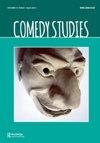《hāsya》和《Nāṭyaśāstra》中的raudra美学:愤怒是喜剧情感的另一面
Q1 Arts and Humanities
引用次数: 0
摘要
摘要本研究探讨了喜剧与愤怒的关系。具体来说,本文通过研究巴拉塔穆尼的Nāṭyaśāstra中提出的情绪理论,分析了愤怒是如何作为漫画的另一面出现的。对喜剧(hāsya)和愤怒(raudra)的表演语言进行了仔细研究。通过分析《hāsya》和《raudra》的特点,试图证明该漫画具有愤怒的变异倾向。本文章由计算机程序翻译,如有差异,请以英文原文为准。
The aesthetics of hāsya and raudra in Nāṭyaśāstra: anger as the flip side of the comic sentiment
Abstract This study looks into the relation between the comic and anger. Specifically, the paper analyses how anger emerges as the flip side of the comic, by studying the theory of emotions as presented in Bharatamuni’s Nāṭyaśāstra. The performative languages of the comic (hāsya) and anger (raudra) are closely examined. By analysing the features of hāsya and raudra the study attempts to prove the mutative tendency of the comic to anger.
求助全文
通过发布文献求助,成功后即可免费获取论文全文。
去求助
来源期刊

Comedy Studies
Arts and Humanities-Literature and Literary Theory
CiteScore
0.60
自引率
0.00%
发文量
26
 求助内容:
求助内容: 应助结果提醒方式:
应助结果提醒方式:


